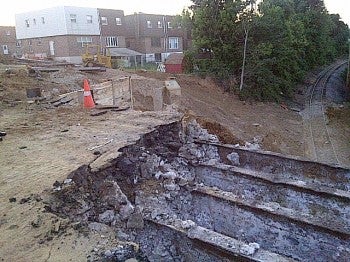PennDOT: “week or so” before Ashton/Willits traffic patterns shift

A month after the Holme Avenue Bridge closed unexpectedly, residents and business owners are still handling the impromptu detours and increased traffic.
One of the busiest intersections, Ashton and Willits roads, has had new traffic lights installed to accommodate more lanes of traffic, but those lights remain dark and covered in plastic. We reached out to PennDOT to find out why.
“This was a time-saving measure so that once our traffic operation plans were finalized, the signals would be in place and ready to go,” Safety Press Officer Jennifer Robinson tells NEast Philly. “Due to the volume and complexity of traffic patterns in the area, our analysis of the revised traffic control plan has been taking a little longer. Our signal experts have nearly completed their review, and we also are coordinating our plans with the city Streets Department.”
But there’s one final step to getting the lights working, as Robinson explains: “We have to coordinate with SEPTA because they have to temporarily relocate a bus stop near the Ashton/Willits intersection. We can’t operate the new signal until SEPTA relocates the stop. Otherwise, safety is jeopardized for pedestrians/bus riders. So, that part of the process unfortunately may take another week or so.”
Continuing coverage
6/30 PennDOT: Bridge “had to close” (with slideshow)
6/21 Bridge closure announcement
4/28 Construction update
2/24 Construction update
We also asked Robinson about a similar bridge project in Montgomery and Chester counties. Much like the Holme Avenue Bridge, the one connecting Spring City and Royersford was to be partially open to traffic as PennDOT performed repairs. Until Monday, that is, when crews found “advanced deterioration” and decided to close it completely for the next eight weeks. The work schedule will be shorter than that of the Holme Avenue Bridge, which won’t be finished until the end of the year, like in Holme Circle, business owners in Spring-Ford are feeling the slow down.
“Fortunately, it is not a common occurrence to have to close a bridge suddenly in the midst of an ongoing project,” Robinson tells NEast. “Usually our advance testing can determine the needed extent of work. And in some cases, we have revised bridge plans based on those advance tests.”
Though uncommon, Holme Circle residents know all too well sudden closures are possible.
“We don’t have the bridge equivalent of an MRI,” Robinson says, “so, on rare occasions such as with Holme Avenue, we uncover additional problems after beginning work. Bridges with masonry work, such as Holme Avenue, present an additional challenge because their structures are harder to test than concrete or steel bridges.”
WHYY is your source for fact-based, in-depth journalism and information. As a nonprofit organization, we rely on financial support from readers like you. Please give today.



